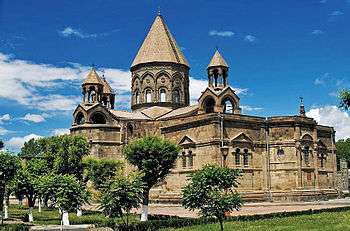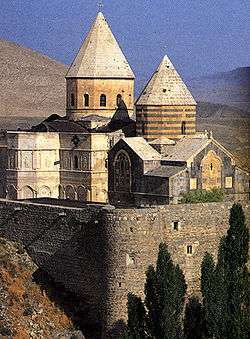Noratus cemetery
|
Khachkars at Noratus Cemetery | |
 Shown within Armenia | |
| Details | |
|---|---|
| Established | 10th century |
| Location | Noratus, Gegharkunik Province, Armenia |
| Coordinates | 40°22′26″N 45°10′52″E / 40.373931°N 45.181233°E |
Noratus cemetery, also spelled Noraduz, (Armenian: Նորատուսի գերեզմանատուն) is a medieval cemetery with a large number of early khachkars located in the village of Noratus, Gegharkunik marz near Gavar and Lake Sevan, 90 km north of Yerevan.[1]
The cemetery has the largest cluster of khachkars in the Republic of Armenia.[2] It is currently the largest surviving cemetery with khachkars following the destruction of the khachkars in Old Julfa, Nakhichevan by the government of Azerbaijan.[3][4][5][6]
Khachkars
The oldest khachkars in the cemetery date back to the late 10th century.[1] During the revival of the khachkar tradition in the 16-17th centuries many khachkars were built under the yoke of the Safavid Empire when oriental influences seeped into Armenian art. Three master carvers from this period carved khachkars in Noraduz, the most notable of whom was Kiram Kazmogh (1551-1610), his contemporaries were Arakel and Meliset.[7] The cemetery is spread over a seven hectare field containing almost a thousand khachkars each of them depicting unique ornamentation.[1] The majority of the khachkars are covered by moss and lichen. Several tombstones in the cemetery depict carved scenes of weddings and farm life. Adjacent to the old cemetery a new modern cemetery has been built separated by a long fence. Nearby the cemetery in the village there is the Holy Virgin church built in the ninth century. One of the khachkars from the cemetery was donated to the British Museum in 1977 by Catholicos Vazgen I.[8][9] The front face of the rectangular khachkar has a leaved-cross with two smaller crosses below that are framed with trefoil and bunches of grapes projecting from either side. An inscription on the left side seeks god's mercy for a certain Aputayli.[8]
Folklore

A popular folktale associated with the cemetery concerns the invading army of Tamerlane. According to one story the villagers placed helmets on top of the khachkars and leaned swords against them. From a distance the khachkars looked like armed soldiers holding a defensive position as a result of which Tamerlane’s army retreated.[1]
In another popular story, the 19th-century monk named Ter Karapet Hovhanesi-Hovakimyan, from a monastery near the village, conducted burial services at Noraduz; in order to avoid the two-hour round trip from the cemetery to the monastery he built himself a small cell in Noraduz.[10] When he was 90 years old, he asked his brother monks to bury him alive. His last words were: "I do not fear death. I would like you to not be afraid also. Never fear anything, but God alone. Let anyone who has fear come to me. Pour water at the burial stone, drink the water, wash your face, chest, arms and legs. Then break the vessel that contained the water. Fear will then abandon you." To this day people come to the monk's grave to perform this ritual, leaving broken pieces of glass scattered all about.[10]
Gallery
 Tombstone depicting a wedding celebration.
Tombstone depicting a wedding celebration. Chapel at the cemetery.
Chapel at the cemetery. Khachkars and a tomb.
Khachkars and a tomb.
 in the early 20th century
in the early 20th century
Notes
| Wikimedia Commons has media related to Noraduz Cemetery. |
| Wikimedia Commons has media related to Noraduz. |
- 1 2 3 4 Hakobyan, Julia (12 September 2003). "Life in the Monuments of Death: A visit to the cemetery village, Noraduz". ArmeniaNow. Archived from the original on 5 December 2014.
- ↑ Kouymjian, Dickran. "Arts of Armenia". Sculpture. Armenian Studies Program, California State University, Fresno. Retrieved 2007-10-10.
- ↑ "World Watches In Silence As Azerbaijan Wipes Out Armenian Culture". The Art Newspaper. 2006-05-25. Retrieved 2007-10-10.
- ↑ "Tragedy on the Araxes". Archaeology. 2006-06-30. Retrieved 2006-06-30.
- ↑ "Azerbaijan: Famous Medieval Cemetery Vanishes". Institute for War and Peace Reporting. 2006-04-19. Retrieved 2007-10-10.
- ↑ European Parliament On Destruction of Cultural Heritage
- ↑ Ney, Richard L. (2005). "Who Made Khachkars?". The Gift of Stone. TourArmenia. Retrieved 2007-10-11.
- 1 2
- Parry, Ken (2007). The Blackwell Companion to Eastern Christianity. Wiley-Blackwell. p. 397. ISBN 0-631-23423-3.
- ↑ British Museum Collection
- 1 2 "Armenia. Stone crosses." (in Russian). Vokrug Sveta. 2003-12-28. Retrieved 2007-10-10.
Further reading
- Mnatsakanian, S. Kh. (1987). Sevan: Hayravank, Noraduz, Batikian, Hatsarat, Masruts Anapat, Shoghagavank, Vanevan, Kotavank, Makenotsats. OEMME. ISBN 88-85822-01-0.
- Marsden, Philip (1995). The Crossing Place: A Journey Among the Armenians. Kodansha International. ISBN 1-56836-052-5.
Coordinates: 40°22′26″N 45°10′52″E / 40.37389°N 45.18111°E



